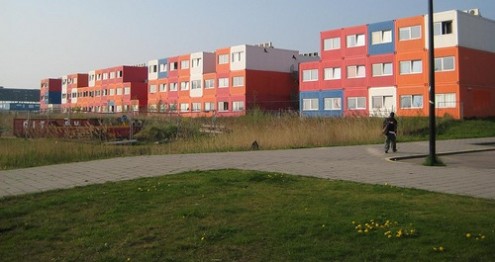
It’s not too much of a surprise that student rooms in Amsterdam are the most expensive in the Netherlands at 100 euro a week, but maybe a little surprising that Dutch student housing is the second most expensive in Europe after the UK at 139 euro a week. Belgian and German neighbours are lucky, paying respectively 66 euro and 57 euro a week.
The typical ‘I’m looking for a room ad’ shows that people are willing to pay just as much and even more than people renting an entire flat to get a room. I also know a lot of Dutch adults who still have roommates, but then the amount of British television shows where adults share flats taught me as a non-European that it’s perfectly normal in Europe.
A few weeks ago I was part of a Canadian documentary about Amsterdam North’s NDSM dock area and both cameramen were stunned by the container village (see pic) that students have to live in, first thinking it was some sort of elaborate artwork. When I told them it was student housing, we talked about the differences between Amsterdam and Montréal were the entire crew and myself are from.
Amsterdam style:
– I actually know rich Dutch parents who bought a second house so that their daughter could have a room and share the house with friends.
– There used to be parties in Amsterdam where students could win a room in a house, not rent-free of course.
– Some adults stay in their student room years after graduation because there are very tough laws about throwing people out of their homes.
Montréal style:
– Student housing provided by universities is overpriced and usually full of foreigners who don’t know better. They usually wise up really quickly and get a normal flat.
– Renting a flat is easy, so there is no need for students to live in student housing. They live in flats just like normal people.
– The idea of renting a room in a house is weird. People rent a flat or share a flat, but don’t usually go looking for a room with the assumption that renting a flat is very difficult like it is in Amsterdam.
(Link: www.iamexpat.nl, Photo of Multi-storey container housing by Rory Hyde, some rights reserved)
 Amsterdam’s famous canal ring turned 400 this year and as part of the celebrations an art exhibit is being held in 15 historical canal houses.
Amsterdam’s famous canal ring turned 400 this year and as part of the celebrations an art exhibit is being held in 15 historical canal houses.


 When I saw this list, I tried first to guess which cities would be on it. Barcelona for sure, having been there and having heard how bad it was, and then I assumed some South American city, but had not guessed Buenos Aires specifically.
When I saw this list, I tried first to guess which cities would be on it. Barcelona for sure, having been there and having heard how bad it was, and then I assumed some South American city, but had not guessed Buenos Aires specifically.
 When I wrote
When I wrote 


